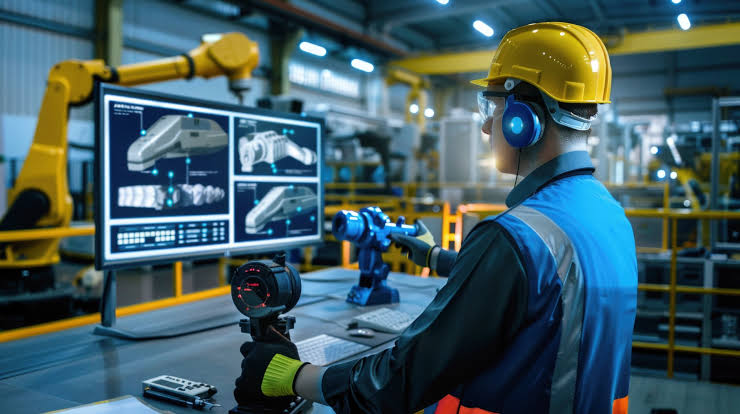Artificial intelligence has become a cornerstone of modern manufacturing by transforming predictive maintenance and quality control.
Globally, the incorporation of artificial intelligence into manufacturing has transformed conventional production methods. By June 2025, AI's contribution to quality control and predictive maintenance will have grown, allowing businesses to run more profitably and produce higher-quality goods. AI is now a necessary tool for both small-scale manufacturers and multinational industrial giants looking to stay innovative and competitive in an era of rapid industrial transformation.
The Development Of Artificial Intelligence In Industrial Settings
From simple automation, artificial intelligence in manufacturing has developed into a powerful system that can make decisions, forecast, and adjust in real time. Manufacturing systems can now identify trends, anticipate equipment failures, and maintain consistent product quality without constant human supervision thanks to the integration of machine learning, computer vision, and advanced data analytics.
These skills are particularly important in high-volume, high-speed settings where even small inefficiencies can result in large losses. The sensors and AI-powered platforms found in today's smart factories keep an eye on the state of the machinery, optimise maintenance plans, and guarantee that the final products fulfil all requirements. This development leads to more sustainable manufacturing practices by increasing productivity, extending machine lifespan, and reducing downtime.
Comprehending Manufacturing Predictive Maintenance
The term "predictive maintenance" describes the application of AI to track the condition of machinery and forecast potential failure times. Predictive maintenance analyses performance trends using real-time data gathered from sensors embedded in equipment rather than depending on regular schedules or waiting for malfunctions.
In order to identify anomalies that occur before mechanical failures, AI models assess variables like temperature, vibration, pressure, and acoustic emissions. Manufacturers can take prompt action to avoid expensive downtime and lower repair costs by anticipating problems before they result in equipment failure.
Traditional reactive or preventive maintenance strategies, which either react to equipment failures or adhere to a set schedule regardless of equipment condition, are in contrast to this proactive approach.
Predictive Maintenance Advantages
For manufacturers, the use of AI-powered predictive maintenance has a number of real advantages. Above all, it drastically lowers unplanned equipment failures, enabling companies to schedule maintenance without stopping output. As a result, overall operational efficiency and equipment reliability are increased. Second, predictive maintenance lowers expenses.
Manufacturers can prolong the life of costly machinery and save money on major repairs by spotting issues early. It also lowers labour costs related to emergency repairs and eliminates the need for redundant spare parts. Increased safety is an additional advantage. Workers are at risk from defective machinery, and artificial intelligence (AI) helps lower the chance of accidents by keeping equipment in top condition.
AI In Inspection And Quality Control
AI is significantly enhancing quality control throughout manufacturing processes, going beyond equipment maintenance. Historically, human judgement or simple imaging systems—both of which are prone to error and inconsistency—were used for quality inspection. By creating automated, intelligent inspection systems that can find even the smallest flaws at a speed that is impossible for human workers to match, artificial intelligence has changed that.
Products on assembly lines are now frequently inspected using computer vision, a branch of artificial intelligence. Real-time analysis of product surfaces, shapes, colours, and textures is possible thanks to these systems' trained machine learning models and high-resolution cameras. Instantaneous flagging of any departure from the ideal standard enables prompt remedial action.
Combining Digital Twins And Industrial IoT
Predictive maintenance and quality control are further improved by the collaboration of AI, digital twins, and the Industrial Internet of Things (IIoT). Large volumes of sensor data are gathered by IIoT devices, and AI analyses this data to provide useful insights. Before making changes in the real world, manufacturers can test maintenance scenarios, simulate operations, and forecast performance outcomes using digital twins, which are virtual copies of physical assets.
When combined, these technologies produce a manufacturing environment that is extremely flexible and responsive. The AI system can notify operators, recommend the best times for maintenance, and update the digital twin to reflect the equipment's evolving state if a machine starts to exhibit symptoms of stress. In a similar vein, any quality-related information gathered during production is utilised to enhance subsequent results and streamline procedures.
Problems And Things To Think About
Adopting AI in manufacturing is not without its difficulties, despite the advantages. The initial outlay for infrastructure and technology is a major obstacle. Budgeting for sensors, cloud storage, AI platforms, and qualified staff may be difficult for smaller manufacturers. Furthermore, it can be difficult and requires careful planning to integrate AI systems with legacy equipment.
The problem of data quality is another. The quality of AI models depends on the data they are fed. Data that is inaccurate, lacking, or inconsistent can result in inaccurate forecasts and lower the dependability of AI-based judgements. Another constant concern in the deployment of AI is ensuring cybersecurity, data privacy, and compliance with changing regulations. Additionally important are change management and training.
AI's Potential In Manufacturing
In the future, artificial intelligence's role in manufacturing will only become more complex. Systems for predictive maintenance will grow increasingly self-sufficient and need less human involvement. Generative AI models that can identify design flaws before production even starts will be incorporated into quality control.
It is anticipated that AI-driven automation will further lower production costs, accelerate time to market, and allow for more product customisation. AI will also play a key role in maximising energy use, lowering carbon footprints, and promoting greener supply chains as sustainability becomes a global necessity.
